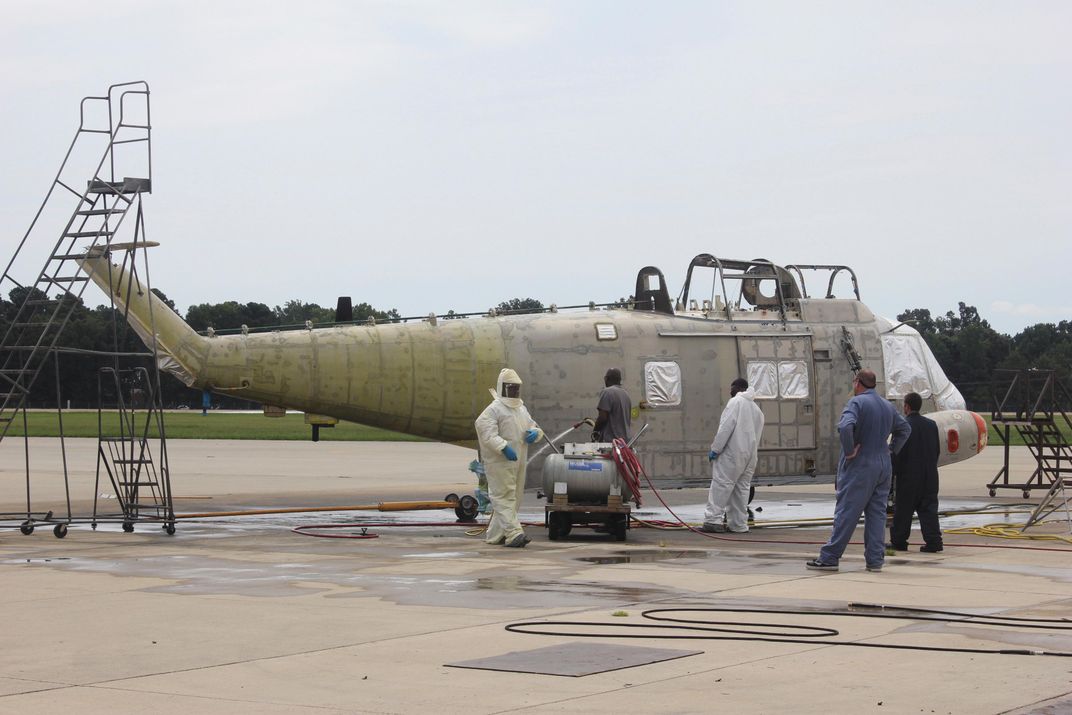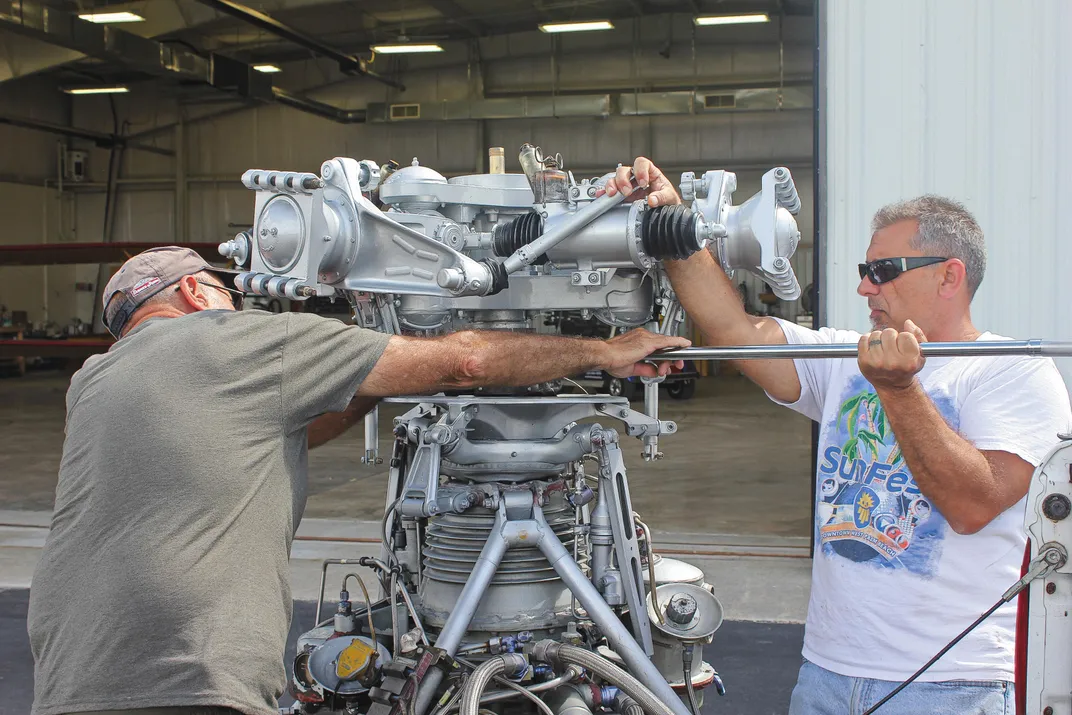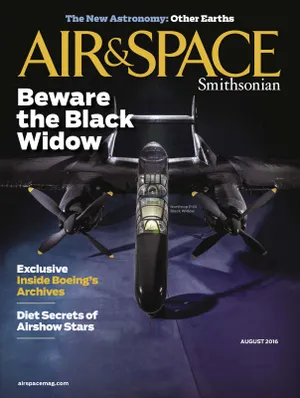At Long Last, The Museum Has a Coast Guard Helicopter
A Sikorsky Seaguard enters the National Air and Space Museum collection.
/https://tf-cmsv2-smithsonianmag-media.s3.amazonaws.com/filer/73/13/7313ed66-7d25-43a2-9854-992750c415f0/16a_aug2016_hh52program4-24-2016-0015_1_live.jpg)
It was a workhorse of Coast Guard aviation, performing air-sea rescues for 26 years, eventually saving more than 15,000 lives. During its long career, the Sikorsky HH-52A Seaguard would become a symbol of the Coast Guard, its primary user. Which is why the Coast Guard Aviation Association—a fraternal organization dedicated to the preservation of Coast Guard history—hoped to donate a Seaguard to the National Air and Space Museum.
The Museum was eager to accept, but there was a catch: Because the Museum, with limited staff, must focus its restoration efforts on aircraft already in the collection, the Seaguard would have to come in fully restored.
Outside restorations are common, says vertical-flight curator Roger Connor, “given that a lot of times a significant restoration on our end takes four to five years and can be an all-hands effort.”
In late 2014, the association had obtained an HH-52A—tail number 1426—from the North Valley Occupational Center in Van Nuys, California, a school specializing in aviation maintenance. The Coast Guard had donated the helicopter to the school in 1989; the school agreed to trade it to the association for a more modern aircraft—an HU-25 Falcon—that was being retired.
The association soon learned that the airframe had a storied past: In 1979, two ships, the Burmah Agate and the Mimosa, collided in the Gulf of Mexico, and Lieutenants Chris Kilgore and J.C. Cobb, along with Petty Officer Thomas Wynn, flew the HH-52A to rescue 22 survivors.
For the restoration, the association partnered with Vector CSP, an engineering and logistics company employing aircraft maintainers, many of whom were Coast Guard veterans. The helicopter was trucked from California to Elizabeth City, North Carolina, for the project.
“We took everything off the helicopter,” says Craig Simmons, a retired Coast Guard chief warrant officer now with Vector CSP. “We had all the flight control rods off, the rotor head, the engine. We took the cockpit all apart.”

During disassembly, Simmons and John Siemens, a former Coast Guard captain, created a worklist: what needed to be repaired, acquired, or fabricated.
The aircraft had been sitting outside for many years, so every crevice was inspected for corrosion. The hardest part of the project was “cleaning up the gunk and the grunge and the residue that was in the bilge for years and years from sitting outside,” says Simmons.
“One of the most difficult structural repairs was replacing the rear cabin floor,” says Siemens. “The aluminum honeycomb floor was completely corroded and caved in. Thankfully, the Coast Guard had four HH-52 hulls that were available for parts. In one of those hulls we found a floorboard that would work for us, although it would need some repair. The floorboards in these aircraft are held in place by over 200 aluminum bolts, and almost every single bolt sheared off when we removed them. This required drilling out and replacing almost every nut plate on the airframe floor flanges.”
At the Museum’s request, some wear and tear was left alone. “The rudder pedals had been buffed to a smooth dull finish from years of pilots’ flight boots,” says Siemens. “We preserved that.” The restorers also left some of the patina on the pilot’s and copilot’s seats. “During the years the 1426 was in service,” says Siemens, “the upper edges of the aluminum seat frames had become worn to a mirror finish as a result of the pilot and copilot entering the cockpit. We preserved that in order to tell the aircraft’s story.”

That same level of care was shown to the main rotor blades, which, on this aircraft, are painted. “We replicated the stencils that were originally on the blades,” says Simmons. “Each blade had a serial number and date of manufacture, and the Sikorsky Aircraft name. We replicated those stencils on the blades even though no one is ever going to see them because the aircraft is hanging too high up.”
After the parts were repaired, they were reassembled and the helicopter was painted. Then it was disassembled again, and each piece was packed in bubble wrap and shipped to the Museum, where the aircraft was reassembled for the final time.
The easiest part of the project? “Getting people to help us,” says Simmons. Most of the volunteers were from crews sent by the Coast Guard from all over the country. Students from the local junior college’s airframe-and-powerplant mechanics program also volunteered.
The Coast Guard volunteers were technicians specializing in aviation maintenance, electronics, and survival, says Siemens. “None were trained in the restoration of a museum artifact, but all were trained in the field-level repair and maintenance of U.S. Coast Guard aircraft. Every volunteer was excited to participate; it’s something very few people get to do, and something they will fondly remember.”
The Seaguard was accepted into the Museum’s collection last April, and many of the restoration staff and volunteers were on hand for the ceremony.
“I was pretty sad when the project was over,” says Simmons. “It was something we looked forward to every day. I dreamed about it at night and came up with some restoration ideas in my dreams. It was all I thought about for a whole year. Now we have to go cold turkey. I got sentimental at the ceremony. We were finished with it and then we just walked away.”
The Coast Guard Association has called the Seaguard “comfortably behind the cutting edge.” But having saved thousands from perhaps more technologically advanced surface vessels that foundered in heavy seas, surrounded by empty ocean, the HH-52A earned a place of honor.
